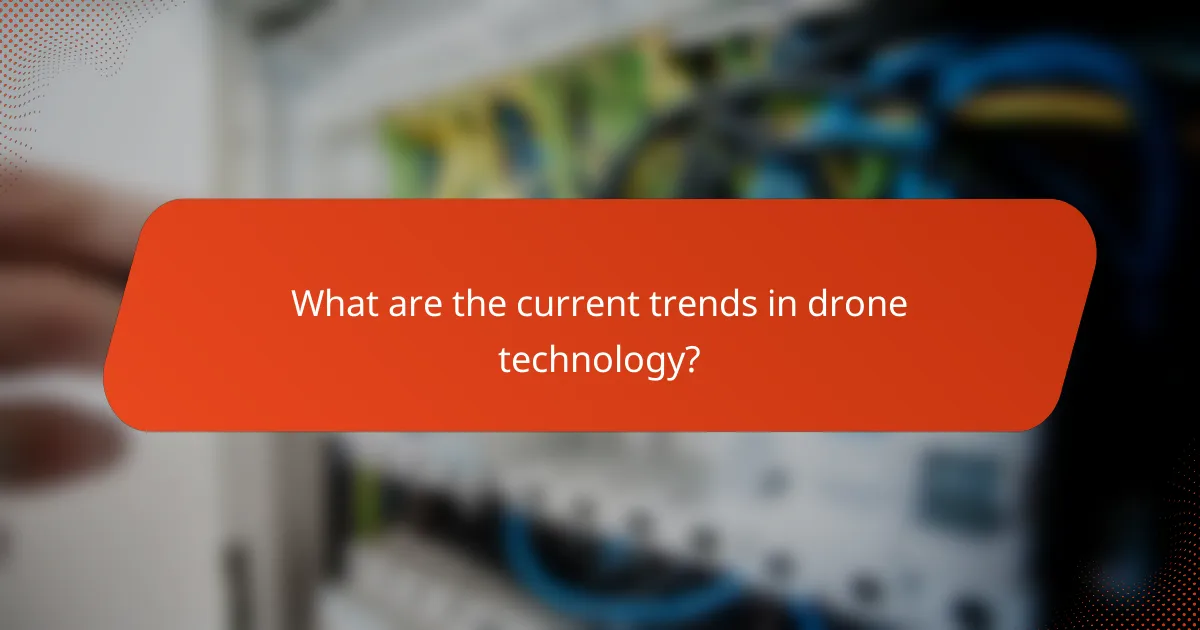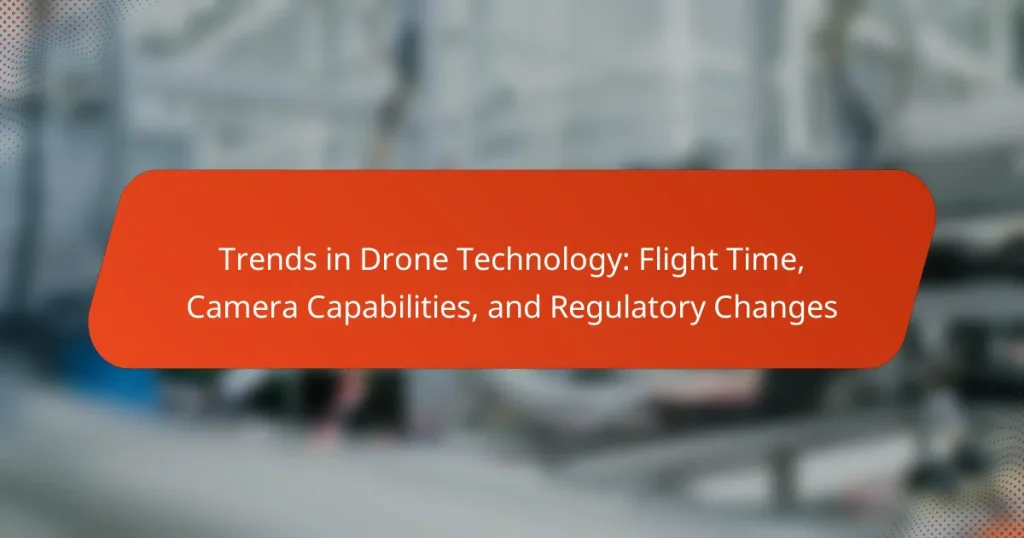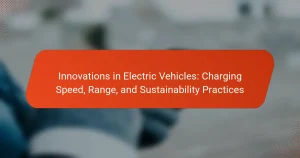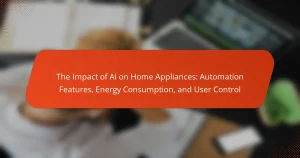Drone technology is rapidly evolving, with significant advancements in three key areas: flight time, camera capabilities, and regulatory frameworks. Manufacturers are producing drones that can achieve flight times exceeding 30 minutes, allowing for more extensive operational applications. Additionally, drones are now equipped with high-resolution cameras, including 4K and 8K video capabilities, enhancing aerial photography and videography. As the use of drones continues to grow, governments worldwide are implementing clearer regulations to ensure safety and facilitate their integration into airspace. These trends highlight the increasing versatility and significance of drones across various industries.

What are the current trends in drone technology?
Current trends in drone technology include advancements in flight time, enhanced camera capabilities, and evolving regulatory frameworks. Manufacturers are developing drones with longer battery life, achieving flight times exceeding 30 minutes. This improvement allows for more extensive operations in various applications. Camera technology is also advancing, with drones now equipped with 4K and even 8K video capabilities. These high-resolution cameras enable detailed aerial photography and videography. Additionally, regulatory changes are being implemented globally to accommodate the growing use of drones. Governments are establishing clearer guidelines for commercial and recreational use, promoting safety and integration into airspace. These trends reflect the increasing importance and versatility of drones in multiple industries.
How is flight time evolving in modern drones?
Flight time in modern drones is significantly increasing due to advancements in battery technology and energy efficiency. New lithium-polymer batteries provide greater energy density, enabling longer flight durations. Many drones now achieve flight times of 30 minutes or more, compared to earlier models that averaged around 10 to 20 minutes. Innovations like lightweight materials also contribute to improved flight efficiency. Additionally, software optimizations enhance battery management systems, prolonging operational time. Research indicates that some high-end commercial drones can now fly for up to 90 minutes on a single charge. These improvements reflect ongoing trends in drone technology focusing on maximizing performance and usability.
What factors influence the flight time of drones?
The flight time of drones is influenced by several key factors. Battery capacity is a primary determinant. Higher capacity batteries, measured in milliamp hours (mAh), provide longer flight times. Weight of the drone also plays a crucial role. Heavier drones consume more energy, reducing flight duration.
Aerodynamics affects flight time as well. Drones designed for better airflow can achieve longer flights. Flight speed impacts energy consumption. Faster speeds typically lead to shorter flight times. Environmental conditions are significant too. Wind resistance can decrease flight efficiency and time.
Payload affects the overall weight and energy usage. Carrying additional equipment reduces flight duration. Finally, the efficiency of the drone’s motors contributes to flight time. More efficient motors use less power, extending flight duration.
How do battery technologies impact drone flight duration?
Battery technologies directly influence drone flight duration by determining energy capacity and efficiency. Higher capacity batteries, such as lithium-polymer, provide longer flight times. For instance, a typical drone battery may offer between 1500 mAh to 5000 mAh. This capacity allows drones to stay airborne from 20 to 40 minutes, depending on weight and power consumption. Additionally, advancements in battery technology, like solid-state batteries, promise even greater energy density. Research indicates that improved battery management systems can optimize energy use, further extending flight duration. Therefore, the type and quality of battery technology are critical for maximizing drone operational time.
What advancements are being made in drone camera capabilities?
Advancements in drone camera capabilities include higher resolution sensors, enhanced stabilization technology, and improved low-light performance. Many drones now feature 4K and even 8K cameras, allowing for ultra-high-definition image capture. Advanced gimbal systems provide superior stabilization, reducing motion blur and improving image clarity during flight. New sensor technologies enable better performance in low-light conditions, expanding usability for nighttime operations. Additionally, AI-driven features are being integrated, such as object tracking and automated image processing. These enhancements lead to more versatile applications in fields like filmmaking, agriculture, and surveillance. According to a report by MarketsandMarkets, the drone camera market is expected to grow significantly, highlighting the demand for these advancements.
What types of cameras are commonly used in drones today?
Drones commonly use several types of cameras today. The most prevalent are RGB cameras, which capture standard color images and videos. These cameras are often used for photography and videography. Another type is multispectral cameras, which capture data across multiple wavelengths. These are essential for agricultural monitoring and environmental studies. Thermal cameras are also widely used. They detect heat signatures, making them valuable for search and rescue operations. Additionally, 4K cameras are increasingly popular due to their high-resolution capabilities. They provide clear and detailed imagery. Each type of camera serves specific purposes, enhancing the versatility of drone applications.
How do camera specifications affect aerial photography quality?
Camera specifications significantly influence aerial photography quality. Higher resolution cameras capture more detail in images. For example, a 20 MP camera provides clearer images than a 12 MP camera. Lens quality also plays a crucial role. Lenses with wider apertures allow more light, improving performance in low-light conditions.
Additionally, sensor size impacts image quality. Larger sensors can capture more light, resulting in better dynamic range and less noise. Frame rate affects the smoothness of video capture. A higher frame rate produces smoother footage, essential for aerial videography.
Stabilization features, such as gimbals, enhance image stability. This reduces blur caused by drone movement. Lastly, the camera’s ISO range determines its performance in varying lighting conditions. A wider ISO range allows for better adaptability to different environments.
What regulatory changes are impacting drone technology?
Recent regulatory changes are significantly impacting drone technology. New rules from the Federal Aviation Administration (FAA) focus on remote identification of drones. This requires operators to broadcast identification information during flight. Additionally, regulations are evolving to allow for expanded operations beyond visual line of sight (BVLOS). These changes aim to enhance safety and integrate drones into the national airspace. The FAA’s Remote ID rule, effective from April 2021, mandates compliance for most drone operators. Furthermore, ongoing discussions about airspace management and drone delivery regulations are shaping future developments. Overall, these regulatory shifts are facilitating broader use of drones in various sectors.
How are governments adapting regulations for drone usage?
Governments are adapting regulations for drone usage by implementing stricter safety and operational guidelines. Many countries are establishing specific airspace restrictions for drone flights. These regulations often include mandatory registration for drone operators. Additionally, governments are requiring pilots to obtain certifications for commercial drone usage. Some regions are integrating drone traffic management systems to prevent collisions. The European Union has introduced a comprehensive framework for drone operations, focusing on safety and privacy. In the United States, the FAA is working on remote identification rules for drones. These adaptations aim to enhance safety and facilitate the integration of drones into national airspace systems.
What are the implications of these regulations for drone manufacturers?
Regulations significantly impact drone manufacturers by imposing compliance requirements. These regulations dictate safety standards, operational limits, and certification processes. Manufacturers must invest in research and development to meet these standards. Compliance can increase production costs and extend time to market. Additionally, regulations may limit design flexibility and innovation. Companies face penalties for non-compliance, affecting their financial stability. Adapting to changing regulations requires continuous monitoring and adjustments in manufacturing practices. Overall, regulations shape the competitive landscape for drone manufacturers.
How do these trends interconnect within the drone industry?
The trends of flight time, camera capabilities, and regulatory changes in the drone industry are interconnected through advancements in technology and compliance requirements. Improved battery technology enhances flight time, allowing drones to carry more sophisticated cameras without compromising performance. Enhanced camera capabilities, such as higher resolution and better stabilization, require longer flight times to maximize their utility in applications like aerial photography and surveying. Regulatory changes often respond to these advancements, ensuring safety and privacy while promoting innovation. For instance, regulations may evolve to accommodate drones with extended flight capabilities and advanced imaging technologies, reflecting the industry’s growth and addressing public concerns. This interconnection drives the development of more efficient and versatile drone systems, influencing market trends and user adoption.
What challenges do these trends present for drone users?
Trends in drone technology present several challenges for users. Increased flight time may lead to longer operational ranges, complicating battery management. Users must monitor battery levels closely to avoid mid-flight failures. Enhanced camera capabilities require users to manage larger data storage needs. This can strain processing resources and necessitate more frequent data transfers. Regulatory changes introduce complexities in compliance. Users need to stay informed about evolving laws and guidelines. Failure to comply can result in fines or operational restrictions. Additionally, advanced features may increase the cost of drones, limiting accessibility for some users. Overall, these trends create a need for greater technical knowledge and resource management among drone operators.
What best practices should drone operators follow to adapt to these trends?
Drone operators should prioritize continuous education on regulatory changes. Staying informed helps ensure compliance with evolving laws. Operators should also invest in high-quality batteries to maximize flight time. Improved battery technology can significantly extend operational durations. Additionally, utilizing drones with advanced camera capabilities enhances aerial photography outcomes. This can lead to better customer satisfaction and business opportunities. Regular maintenance of drones is crucial for optimal performance. Well-maintained drones are less likely to malfunction during flight. Lastly, adopting data analytics can improve operational efficiency. Analyzing flight data helps operators make informed decisions and improve performance.
Trends in drone technology encompass advancements in flight time, camera capabilities, and evolving regulatory frameworks. Key developments include longer battery life, enabling flight times exceeding 30 minutes, and enhanced camera technology with 4K and 8K capabilities for improved aerial photography. Regulatory changes are being implemented globally to ensure safety and facilitate the integration of drones into airspace. These interconnected trends highlight the increasing versatility and importance of drones across various industries, while also presenting challenges for users in terms of compliance and operational management.




